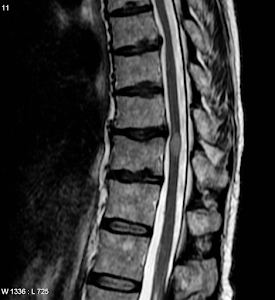Unlocking the Mysteries of Lateral Medullary Syndrome: A Journey through Brainstem Disruption
Lateral Medullary Syndrome, also known as Wallenberg Syndrome
Clinical Picture: A 65 M presents with sudden onset ataxia, slurred speech and vomiting. Known case of Hypertension and Diabetes mellitus . On examination he has no power loss in the limbs, features of Horner syndrome on right side and loss of pain and temperature sensation on right side of the body and left side of his face.
Other systems are normal.
The region infarcted in lateral medullary syndrome is seen in the illustration above. The posterior inferior cerebellar artery, a branch of the vertebral artery, is the artery that gets injured.

With the aid of the simple neuroanatomy of the medulla and its section at the level of the inferior olivary nucleus, as previously demonstrated, we may determine which structures are affected.
Structures involved are:
- Inferior Cerebellar Peduncle
- Vagus nerve nuclei - Nucleus tractus solitarius, Dorsal nucleus of vagus and Nucleus ambiguus
- Vestibular Nuclei
- Sympathetic fibers
- Trigeminal Nerve nucleus and its tract
- Spinothalamic tract
After knowing the structures involved lets look into the functions compromised due to their involvement.
- The inferior cerebellar peduncle involvement causes Ipsilateral Ataxia
- The Vagus nerve involvement leads to slurring of speech, as the Nucleus Ambiguus gives out the Special Visceral efferent supply to the muscles of larynx and pharynx.
- Vertigo, tinnitus and nystagmus can be seen due to Vestibular Nucleus involvement.
- Ipsilateral Horner's syndrome due to infarction of the sympathetic fibers.
- Ipsilateral loss of pain and temperature sensation from the face due to compromised trigeminal nerve.
- Contralateral loss of pain and temperature due to spinothalamic tract involvement. It is contralateral because the axons cross to the opposite side at the level of the spinal cord before entering the medulla.
So the above signs and symptoms when seen in a patient help us localize the lesion in the Nervous System.
Diagnostics and Management
It is same as any other stroke case-
(@Amboss)
Complications
Medical complications common to all strokes:
- Aspiration Pneumonia
- Deep vein thrombosis
- Pulmonary Embolism
- Urinary tract infections
- Delirium
- Depression
- Cardiac Dysfunction
Neurological Complications:
- Seizures
- Raised intracranial pressure
- SIADH
- Aphasia
- Central Neuropathic pain
SG
Resources
Snells Neuroanatomy
Amboss library
Vishram Singh Neuroanatomy








Comments
Post a Comment